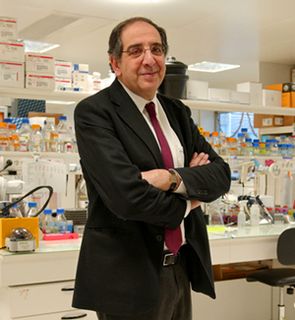ARVO 2015 Highlight: New Research Boosts Prospects for Saving Vision with RdCVF
Eye On the Cure Research News
After years of refinement and testing in animal models, the emerging therapy is about a year and a half from moving into a clinical trial.

Dr. José Sahel. Photo courtesy of the Institut de la Vision.
An eye doctor could preserve meaningful vision in people with advanced retinitis pigmentosa (RP) by saving just five percent of their cones, the cells concentrated in the central retina enabling us to read, recognize colors and see in lighted conditions.
That was the impetus for Foundation-funded researchers José Sahel, M.D., and Thierry Léveillard, Ph.D., to search for, and ultimately discover, a cone-saving protein they call rod-derived cone-viability factor, or RdCVF. After years of refinement and testing in animal models, the emerging therapy is about a year and a half from moving into a clinical trial at the Foundation-funded Paris Research Center for the Study of Retinal Degenerative Diseases.
While the two scientists from the Institut de la Vision have been optimistic about the ability of RdCVF to save vision in people, results from a new study, reported at ARVO and published in the journal Cell, have taken their confidence to a new level. By studying RdCVF in mice and chickens, the latter of which have cone-rich retinas, they identified its mechanism of action. In other words, now they know precisely why it works so well.
The researchers found that RdCVF boosts the uptake of energy to the cones. Also, the protein may help regenerate cone outer segments, the protrusions which make vision possible by capturing and processing light, but are often lost in retinal degenerative diseases.
"The mode of action of RdCVF is appealing since it opens a new avenue of research aimed at promoting the re-growth of cone outer segments and restoring lost visual acuity in RP," says Dr. LÌ©viellard. "It is also an entirely novel neuroprotective mechanism for preserving cones."
RdCVF will be administered to patients as a gene therapy. A human-engineered virus known as an adeno-associated virus (AAV) will deliver copies of a gene that expresses RdCVF to cones. A single injection of the treatment, made underneath the retina, will likely work for several years.
A key benefit of RdCVF is that it works independent of the mutated gene causing vision loss. While it has been evaluated for several different forms of RP, RdCVF may also be effective for other retinal conditions.
"This new research represents a massive amount of work led by Thierry and provides a valuable elucidation of RdCVF's mechanism of action," says Dr. Sahel. "It follows decades of FFB support for Thierry and me, and the advancement of RdCVF toward a human study."




